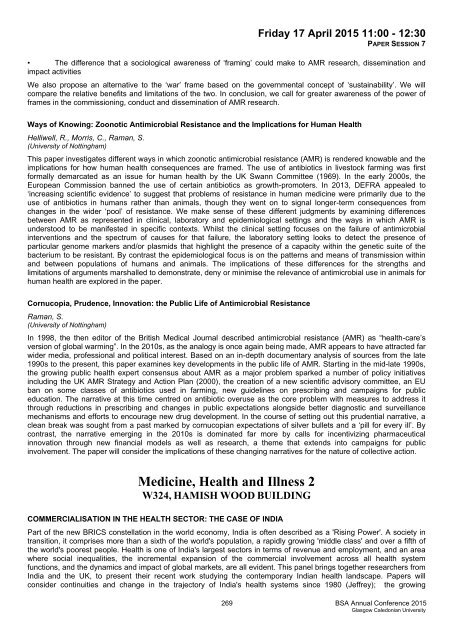Programme full
Programme full
Programme full
You also want an ePaper? Increase the reach of your titles
YUMPU automatically turns print PDFs into web optimized ePapers that Google loves.
Friday 17 April 2015 11:00 - 12:30<br />
PAPER SESSION 7<br />
• The difference that a sociological awareness of ‘framing’ could make to AMR research, dissemination and<br />
impact activities<br />
We also propose an alternative to the ‘war’ frame based on the governmental concept of ‘sustainability’. We will<br />
compare the relative benefits and limitations of the two. In conclusion, we call for greater awareness of the power of<br />
frames in the commissioning, conduct and dissemination of AMR research.<br />
Ways of Knowing: Zoonotic Antimicrobial Resistance and the Implications for Human Health<br />
Helliwell, R., Morris, C., Raman, S.<br />
(University of Nottingham)<br />
This paper investigates different ways in which zoonotic antimicrobial resistance (AMR) is rendered knowable and the<br />
implications for how human health consequences are framed. The use of antibiotics in livestock farming was first<br />
formally demarcated as an issue for human health by the UK Swann Committee (1969). In the early 2000s, the<br />
European Commission banned the use of certain antibiotics as growth-promoters. In 2013, DEFRA appealed to<br />
‘increasing scientific evidence’ to suggest that problems of resistance in human medicine were primarily due to the<br />
use of antibiotics in humans rather than animals, though they went on to signal longer-term consequences from<br />
changes in the wider ‘pool’ of resistance. We make sense of these different judgments by examining differences<br />
between AMR as represented in clinical, laboratory and epidemiological settings and the ways in which AMR is<br />
understood to be manifested in specific contexts. Whilst the clinical setting focuses on the failure of antimicrobial<br />
interventions and the spectrum of causes for that failure, the laboratory setting looks to detect the presence of<br />
particular genome markers and/or plasmids that highlight the presence of a capacity within the genetic suite of the<br />
bacterium to be resistant. By contrast the epidemiological focus is on the patterns and means of transmission within<br />
and between populations of humans and animals. The implications of these differences for the strengths and<br />
limitations of arguments marshalled to demonstrate, deny or minimise the relevance of antimicrobial use in animals for<br />
human health are explored in the paper.<br />
Cornucopia, Prudence, Innovation: the Public Life of Antimicrobial Resistance<br />
Raman, S.<br />
(University of Nottingham)<br />
In 1998, the then editor of the British Medical Journal described antimicrobial resistance (AMR) as “health-care’s<br />
version of global warming”. In the 2010s, as the analogy is once again being made, AMR appears to have attracted far<br />
wider media, professional and political interest. Based on an in-depth documentary analysis of sources from the late<br />
1990s to the present, this paper examines key developments in the public life of AMR. Starting in the mid-late 1990s,<br />
the growing public health expert consensus about AMR as a major problem sparked a number of policy initiatives<br />
including the UK AMR Strategy and Action Plan (2000), the creation of a new scientific advisory committee, an EU<br />
ban on some classes of antibiotics used in farming, new guidelines on prescribing and campaigns for public<br />
education. The narrative at this time centred on antibiotic overuse as the core problem with measures to address it<br />
through reductions in prescribing and changes in public expectations alongside better diagnostic and surveillance<br />
mechanisms and efforts to encourage new drug development. In the course of setting out this prudential narrative, a<br />
clean break was sought from a past marked by cornucopian expectations of silver bullets and a ‘pill for every ill’. By<br />
contrast, the narrative emerging in the 2010s is dominated far more by calls for incentivizing pharmaceutical<br />
innovation through new financial models as well as research, a theme that extends into campaigns for public<br />
involvement. The paper will consider the implications of these changing narratives for the nature of collective action.<br />
Medicine, Health and Illness 2<br />
W324, HAMISH WOOD BUILDING<br />
COMMERCIALISATION IN THE HEALTH SECTOR: THE CASE OF INDIA<br />
Part of the new BRICS constellation in the world economy, India is often described as a 'Rising Power'. A society in<br />
transition, it comprises more than a sixth of the world's population, a rapidly growing 'middle class' and over a fifth of<br />
the world's poorest people. Health is one of India's largest sectors in terms of revenue and employment, and an area<br />
where social inequalities, the incremental expansion of the commercial involvement across all health system<br />
functions, and the dynamics and impact of global markets, are all evident. This panel brings together researchers from<br />
India and the UK, to present their recent work studying the contemporary Indian health landscape. Papers will<br />
consider continuities and change in the trajectory of India's health systems since 1980 (Jeffrey); the growing<br />
269 BSA Annual Conference 2015<br />
Glasgow Caledonian University


